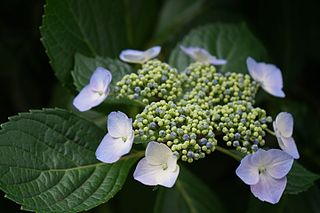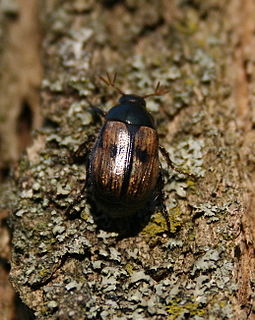
Anomura is a group of decapod crustaceans, including hermit crabs and others. Although the names of many anomurans include the word crab, all true crabs are in the sister group to the Anomura, the Brachyura.

Hydrangea anomala, the Japanese climbing-hydrangea, is a species of flowering plant in the family Hydrangeaceae native to the woodlands of the Himalaya, southern and central China and northern Myanmar.

Hydrangea petiolaris, a climbing hydrangea, is a species of flowering plant in the family Hydrangeaceae native to the woodlands of Japan, the Korean peninsula, and on Sakhalin island of easternmost Siberia in the Russian Far East.

Anomala is a genus of shining leaf chafers in the family of beetles known as Scarabaeidae. There are at least 1,200 described species in Anomala.
Pichia is a genus of yeasts in the family Saccharomycetaceae with spherical, elliptical, or oblong acuminate cells. Pichia is a teleomorph, and forms hat-shaped, hemispherical, or round ascospores during sexual reproduction. The anamorphs of some Pichia species are Candida species. The asexual reproduction is by multilateral budding.

The bloody-red mysid, Hemimysis anomala, is a shrimp-like crustacean in the Mysida order, native to the Ponto-Caspian region, which has been spreading across Europe since the 1950s. In 2006, it was discovered to have invaded the North American Great Lakes.

Anisogramma anomala is a plant pathogen that causes a disease known as Eastern filbert blight on Corylus spp. (hazelnut). Also known as EFB.
The bob-tailed weaver is a species of bird in the family Ploceidae. It is monotypic within the genus Brachycope. It is found in Cameroon, Central African Republic, Republic of the Congo, and Democratic Republic of the Congo.

Thalassina is a genus of mud lobsters found in the mangrove swamps of the Indian Ocean and western Pacific Ocean. Its nocturnal burrowing is important for the recycling of nutrients in the mangrove ecosystem, although it is sometimes considered a pest of fish and prawn farms.

Fraxinus anomala is a species of ash tree known by the common name single-leaf ash. It is native to the southwestern United States and northern Mexico, where it grows in a number of habitats including desert scrub and chaparral. It is unusual in the genus in that some specimens have simple leaves instead of the pinnate leaves more characteristic of the group.

Anomala binotata is a species of shining leaf chafer in the family of scarab beetles, Scarabaeidae. The common name "shining leaf chafer" is sometimes applied to this species specifically, but is more often used to describe all members of the subfamily Rutelinae.

Paeonia veitchii is a species of herbaceous perennial peony. The vernacular name in China is 川赤芍. This species is ½-1 m high, has a thick irregular taproot and thin side roots, and deeply incised leaves, with leaflets themselves divided in fine segments. It has two to four fully developed flowers per stem, that may be pink to magenta-red or rarely almost white. It is known from central China.

Paeonia anomala is a species of herbaceous perennial peony. The vernacular name in Russia is Пион необыча́йный meaning "anomalous peony", in Kazakh it is called кәдімгі Таушымылдық "common peony", in Mongolia Ягаан цээнэ "pink peony", and in China 新疆芍药, "Xinjiang peony". These plants are ½-1 m high, have a thick irregular taproot and thin side roots, and deeply incised leaves, with leaflets themselves divided in fine segments. It has almost always only one fully developed flower per stem, magenta-red or rarely pink or white. The species occurs in a zone between northern European Russia and northern Mongolia and south to the Tien Shan Mountains. P. anomala bears flowers in early summer.
Peronia anomala is a species of air-breathing sea slug, a shell-less marine pulmonate gastropod mollusk in the family Onchidiidae. It is the most recently discovered species of the genus of Peronia, found in the Red Sea in 1934.

Novocrania anomala is a species of brachiopod found offshore in the eastern Atlantic Ocean.

Hypolimnas anomala, the Malayan eggfly or crow eggfly is a species of eggfly.
Symplocos anomala is a plant in the family Symplocaceae.
Pichia anomala is a species of ascomycete and teleomorphic fungi of the genus Pichia. It is used as a preventive for undesirable fungi or mold, nevertheless it may spoil food in large quantities. It is used in wine making, airtight stored grain, apples, and grapevines. P. anomala has been reclassified as Wickerhamomyces anomalus.

Thalassina anomala, known as the scorpion mud lobster, is a species of crustacean in the family Thalassinidae.












